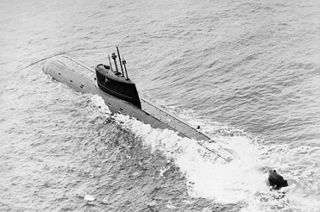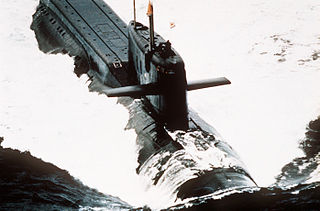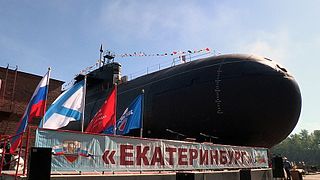
K-219 was a Project 667A Navaga-class ballistic missile submarine of the Soviet Navy. It carried 16 R-27U liquid-fuel missiles powered by UDMH with nitrogen tetroxide (NTO), and equipped with either 32 or 48 nuclear warheads. K-219 was involved in what has become one of the most controversial submarine incidents during the Cold War on Friday 3 October 1986. The 15-year-old vessel, which was on an otherwise routine Cold War nuclear deterrence patrol in the North Atlantic 1,090 kilometres (680 mi) northeast of Bermuda, suffered an explosion and fire in a missile tube. While underway submerged the seal in a missile hatch cover failed, allowing high-pressure seawater to enter the missile tube and owing to the pressure differential rupture the missile fuel tanks, allowing missile's liquid fuel to mix and ultimately combust. Though there was no official announcement, the Soviet Union claimed the leak was caused by a collision with the submarine USS Augusta. Although Augusta was operating within the area, both the United States Navy and the commander of K-219, Captain Second Rank Igor Britanov, deny that a collision took place.

K-19 was the first submarine of the Project 658 class, the first generation of Soviet nuclear submarines equipped with nuclear ballistic missiles, specifically the R-13 SLBM. The boat was hastily built by the Soviets in response to United States' developments in nuclear submarines as part of the arms race. Before she was launched, 10 civilian workers and a sailor died due to accidents and fires. After K-19 was commissioned, the boat had multiple breakdowns and accidents, several of which threatened to sink the submarine.

The K-278 Komsomolets was the Project-685 Plavnik, nuclear-powered attack submarine of the Soviet Navy; the only submarine of her design class.

A ballistic missile submarine is a submarine capable of deploying submarine-launched ballistic missiles (SLBMs) with nuclear warheads. The United States Navy's hull classification symbols for ballistic missile submarines are SSB and SSBN – the SS denotes submarine, the B denotes ballistic missile, and the N denotes that the submarine is nuclear powered. These submarines became a major weapon system in the Cold War because of their nuclear deterrence capability. They can fire missiles thousands of kilometers from their targets, and acoustic quieting makes them difficult to detect, thus making them a survivable deterrent in the event of a first strike and a key element of the mutual assured destruction policy of nuclear deterrence.

USS Augusta (SSN-710), a Los Angeles-class submarine, was the first ship of the United States Navy to be named for Augusta, Maine. The contract to build her was awarded to the Electric Boat Division of General Dynamics Corporation in Groton, Connecticut on 31 October 1973 and her keel was laid down on 1 April 1983. She was launched on 21 January 1984 sponsored by Mrs. Diana D. Cohen, wife of U.S. Senator William Cohen and commissioned on 19 January 1985.

The Yankee class, Soviet designations Project 667A Navaga (navaga) and Project 667AU Nalim (burbot), was a series of nuclear-powered ballistic missile submarines built in the Soviet Union for the Soviet Navy. In total, 34 units were built: 24 in Severodvinsk for the Northern Fleet and the remaining 10 in Komsomolsk-on-Amur for the Pacific Fleet. Two Northern Fleet units were later transferred to the Pacific. The lead boat K-137 Leninets received its honorific name on 11 April 1970, two and one half years after being commissioned.

A nuclear submarine is a submarine powered by a nuclear reactor, but not necessarily nuclear-armed. Nuclear submarines have considerable performance advantages over "conventional" submarines. Nuclear propulsion, being completely independent of air, frees the submarine from the need to surface frequently, as is necessary for conventional submarines. The large amount of power generated by a nuclear reactor allows nuclear submarines to operate at high speed for long periods, and the long interval between refuelings grants a range virtually unlimited, making the only limits on voyage times being imposed by such factors as the need to restock food or other consumables.

The Echo class were nuclear cruise missile submarines of the Soviet Navy built during the 1960s. Their Soviet designation was Project 659 for the first five vessels, and Project 675 for the following twenty-nine. Their NATO reporting names were Echo I and Echo II. All were decommissioned by 1994.

Kirov is the lead ship of the Kirov class of nuclear-powered guided missile cruisers. Originally built for the Soviet Navy and passed onto the succeeding Russian Navy, she and her three sister ships are the largest and heaviest surface combatant warships built by them. The Soviet classification of the ship-type is "heavy nuclear-powered guided missile cruiser", nonetheless Kirov's size and weapons complement have earned her the unofficial designation of a battlecruiser throughout much of the world, as her size and displacement is similar to a typical World War I battleship. The appearance of the Kirov class was a significant factor in the U.S. Navy recommissioning the Iowa class. She was named after a Project 26 cruiser.

The Delta class, Soviet designations Project 667B Murena, Project 667BD Murena-M, Project 667BDR Kalmar, Project 667BDRM Delfin, are a series of third generation nuclear-powered ballistic missile submarines, designed and built in the Soviet Union, which formed the backbone of the Soviet and Russian strategic submarine fleet since their introduction in 1973. They carry nuclear ballistic missiles of the R-29 Vysota family, with the Delta I, Delta II, Delta III and Delta IV classes carrying the R-29, R-29D, R-29R and R-29RM respectively. The Delta I class carried 12 missiles, while the Delta II class which are lengthened versions of the Delta I class carry 16 missiles. The Delta III and Delta IV classes carry 16 missiles with multiple warheads and have improved electronics and noise reduction.
The Delta III-class submarine, Soviet designation Project 667BDR Kaľmar (Squid), is a large ballistic missile submarine operated by the Russian Navy. Like other previous Delta-class submarines, the Delta III class is a double hulled design, with a thin low magnetic steel outer hull wrapped around a thicker inner pressure hull.
Captain Second Rank Igor Anatolievich Britanov, Soviet Navy was the captain of the Soviet missile submarine K-219 when it sank off the coast of Bermuda on October 3, 1986.

JSC PO Sevmash is a Russian joint-stock company (JSC) under the vertically-integrated United Shipbuilding Corporation. The shipbuilding operations of Sevmash is in the port city of Severodvinsk on the White Sea in the Russian Federation.

The K-129 was a Project 629A diesel-electric-powered ballistic-missile submarine that served in the Pacific Fleet of the Soviet Navy–one of six Project 629 strategic ballistic-missile submarines assigned to the 15th Submarine Squadron based at Rybachiy Naval Base near Petropavlovsk, commanded by Rear Admiral Rudolf Golosov.

K-211 Petropavlovsk-Kamchatskiy is a Project 667BDR Kalmar class Russian nuclear ballistic missile submarine. The submarine was built by Sevmash, Severodvinsk in the late 1970s and joined the Soviet fleet in 1980. The submarine continued to serve in the Russian Navy as part of the Pacific Fleet after the collapse of the Soviet Union. She was decommissioned in 2010 and is currently laid up, awaiting disposal. Her role and those of the other boats of her class is being taken by the new Borei-class submarines.
The decommissioning of Russian nuclear-powered vessels is an issue of major concern to the United States and to the Scandinavian countries near Russia. From 1950 to 2003, the Soviet Union and its major successor state, Russia, constructed the largest nuclear-powered navy in the world, more ships than all other navies combined: 248 submarines, four Kirov-class battlecruisers, and a missile test ship, as well as nine icebreakers. Many were or are powered by two reactors each, bringing the total to 468 reactors. With the end of the Cold War and with its navy chronically underfunded, Russia has decommissioned many of these vessels, and according to one report dated November 2008, intended to scrap all decommissioned submarines by 2012. However, the safety records of the Soviet and Russian navies and the budgetary constraints on the Russian government are matters of great concern. Ships awaiting decommissioning receive little maintenance, and there are insufficient waste storage facilities, raising worries about possible ecological damage from accidents or improper storage.

K-84 Ekaterinburg is a Project 667BDRM Delfin class nuclear-powered ballistic missile submarine. The submarine was laid down on 17 February 1982 at the Russian Northern Machine-Building Enterprise (Sevmash). It was commissioned into the Soviet Navy on 30 December 1985. After the collapse of the Soviet Union, the submarine continued to serve in the Russian Navy. Initially known only by her hull number, in February 1999 she was renamed after the city of Yekaterinburg.

K-114 Tula is a Project 667BDRM Delfin-class nuclear-powered ballistic missile submarine (SSBN). As such, she carries a complement of R-29RM Shtil and R-29RMU Sineva nuclear submarine-launched ballistic missiles (SLBM) as her primary deterrent mission, along with anti-ship missiles and torpedoes, the latter for self-defense. Built in Severodvinsk during the late 1980s, she served with the Soviet Navy before being transferred to the Russian Navy following the dissolution of the Soviet Union. Tula underwent an extensive overhaul during 2000–2004 and was fitted with upgraded Shtil SLBMs, several of which were launched from her during her later operational life. She was sponsored by the city of Tula, and is homeported in Gadzhiyevo.

K-18 Karelia is a Project 667BDRM Delfin-class nuclear-powered ballistic missile submarine currently in service with the Russian Navy. It was built in Severodvinsk by Sevmash shipbuilding company and was commissioned in 1989. It was refitted from 2004 to 2009, after which it returned to the navy.














